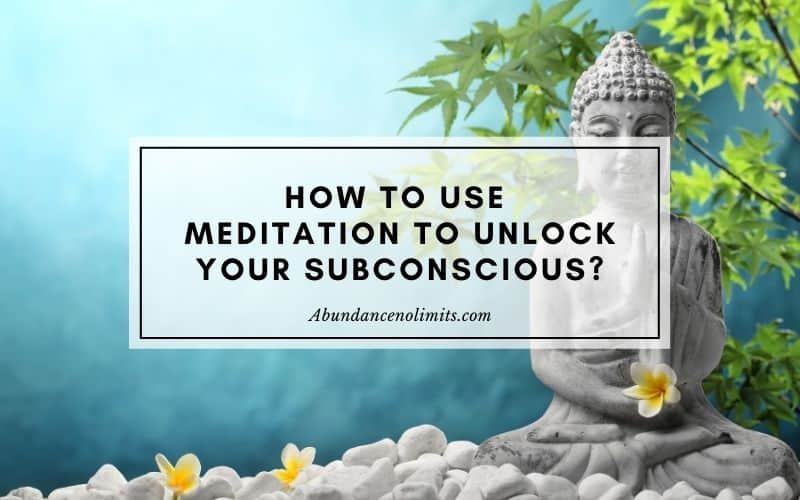Have you noticed that you do most of your daily activities on autopilot? A study by Harvard has found that we spend as much as 47% of a day on autopilot. This means we are paying attention to what we are doing only for half of a day. Unbelievable, isn’t it?
As such, there is no harm in functioning on autopilot. When we are running on autopilot, we rely on our subconscious mind for guidance and run the show. The trouble is that it can guide us in the wrong direction if it is not programmed right. Our life experiences, memories, thoughts, and beliefs stored in the subconscious mind can misguide us if we are not conscious about what we are doing.
Or else, we can reprogram the subconscious mind to get rid of the negativity stored in it, making it guide us in the right direction when we are on autopilot. Gaining access to the subconscious and unlocking it to eliminate undesirable elements stored in it can be achieved through meditation.
Meditation is a powerful tool to hack into your subconscious. Harvard researchers have found that subconscious meditation can enhance your learning skill and memory and reduce fear, anxiety, and stress. It can improve your ability to focus and enhance your cognitive skills.
This article examines the subconscious mind meditation technique that works by altering brain waves. This helps in refocusing the attention from the external to the internal.
Manipulating brain waves
Our brain is an electrochemical organ composed of nerve cells. It uses electric signals for internal communication. The fluctuations of electric voltage between various parts of the brain result in a flow of electric current known as brain waves.
Types of brainwaves
Brain waves are categorized into four based on their frequencies and the level of activity involved. When the brain is in the most active mode, it generates high-frequency beta waves. Beta brainwaves are further divided into low-range, mid-range, and high-range – the high-range beta waves being the most active and stressed-out state.
In this state, your mind would be fully focused and on high alert. Though this is desirable when facing a life-threatening situation, it can cause harm if this state is prolonged or if triggered by regular everyday activities.
- Alpha brainwaves relate to a restful and calm state of mind. A person pausing work and taking time out to relax is in an alpha state. You need to be in an alpha state for meditation.
- Theta brainwaves are associated with introspection and focusing inward. A person who finds it difficult to recall the last five minutes even while continuing productive work is said to be in a theta state of mind. You need to reach the theta state to establish communication between conscious and subconscious minds and gain access to the subconscious.
- Delta brainwaves are generated when you are in deep dreamless sleep. It is the lowest level of activity you can achieve.
Meditation and brainwaves
Subconscious meditation techniques are aimed at lowering the frequency of the brainwaves and shift the attention from outwards to inwards. Only by doing this, you would be able to reach the theta brainwave level and access your subconscious mind.

Here are the steps for unlocking the mind through meditation.
Step 1: Initiation
The first step in the meditation process would be to maintain the focus of the thoughts on something stable. This can bring down the frequency of the brainwaves. By doing this, the logical side of the brain stops functioning and triggers the sense mode. In the sense mode, your feeling is the dominating aspect.
You can achieve this state by focusing on the body. Starting from the head and moving down to the toe, focus on each part of the body, seeing each one of them in the mind’s eye and imagining the feeling in them.
Without breaking the focus, move on to the body as a whole. Then picture the body along with the air surrounding it. At this stage, your focus would fade away from the body and move towards the mind. Finally, lift yourself out of your body, rise above it, and view it from above.
You can achieve the same result by the “flood the room” approach. In this, you feel each body part as the imagined water level rises and touches it. Then your body is fully immersed in water and finally, floating away, separating the body from the mind.
Step 2: Access your subconscious mind
As you reach the subconscious, examine it to identify and acknowledge the flaw or limitation you want to eliminate, overcome, or undo. Even before you embark on the meditation process, you should have identified which one to focus on.
As you are examining the subconscious and recognizing the limitation you want to be removed, accept yourself as you are now with all your flaws and imperfections. You need to acknowledge that a gap exists between your actual self and your actions.
Step 3: Surrender to the higher power
Once you acknowledge the existence of the limitation, you surrender it to the higher power. It is immaterial what you call it – the Universe, God, guardian angel, or quantum field. The surrendering needs to be done without judgment.
You should not judge your flaws, limitations, or shortcomings. Just admit their existence and recognize the feeling in you to change them.
Step 4: Take a step back and observe
Visualize your thoughts and feelings about the limitation you want to be removed. Imagine yourself doing things that are connected with the limitation. Play it in your mind’s eye like a movie. You watch yourself go through the act until you are familiar with the sequence of events, the triggers, and the consequences. These are your habits, provocations, and emotions.
Step 5: Transform
As you are watching this movie of you dealing with the limitation that needs to be discarded, you command it to stop and change. You should say this with utmost conviction and authority to be effective.
Step 6: Confirm and refresh
For the subconscious to listen to your command to stop and change, your thoughts and emotions also need to be in agreement with this. You should want the change to happen and you should desire for the change.
You may finish the session by imagining your new self without the limitation. Find out how differently you are behaving, how different your feelings and thoughts are, and how your general outlook has changed.
Final word
Human beings are designed with three well-defined partitions in the brain – thoughts, emotions, and subconscious. This is both a boon and a bane. Without a proper understanding of the powers and weaknesses of each one of them, living a well-balanced life would be impossible. You would succumb to depression and frustration sooner or later.
Not accessing or utilizing your subconscious mind would be a paramount waste of resources at hand. A veritable treasure trove of information, powers of the mind can be exploited with meditation that aims at lowering the frequency of brain waves. Follow this up by commanding your thoughts and emotions to accept the change.
You may also want to take a look at our guide on how to find Inner peace with yourself.


